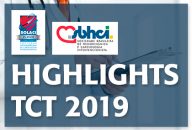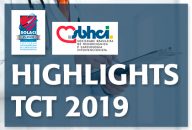Permanent pacemaker implantation following transcatheter aortic valve replacement (TAVR) continues to be one of the most frequent complications. Even though its real impact on prognosis continues to be controversial, its impact on healthcare cost is out of the question, in addition to being uncomfortable for patients. This study, soon to be published in J Am…
More Evidence on Tricuspid Valve Repair
While still lacking large-scale randomized trials, evidence is slowly building for transcatheter tricuspid valve repair. This work, presented at the TCT 2019 Congress and simultaneously published in JACC, shows that transcatheter tricuspid valve repair is not only feasible, but also likely to reduce the rates of mortality and heart failure rehospitalization compared with medical therapy alone.…
TAVR Offers Better Quality of Life to Low Risk Patients
Courtesy of Dr. Carlos Fava. As we all know, TAVR is gaining ground fast in the lower risk patient population, but in addition to analyzing the most important events, researchers are increasingly looking at health status, not only at hospital level, but also after one year. This study looked into PARTNER 3 patient health status…
TCT 2019 | PCI in Stable CAD. Prior TAVR, with TAVR or Never?
Courtesy of SBHCI. This interesting study presented at TCT 2019 and simultaneously published in Am J Cardiol tells us PCI in stable coronary artery disease cannot lower risk in patients with severe aortic stenosis undergoing transcatheter aortic valve replacement (TAVR). Unless patients are symptomatic, most coronary artery lesions do not need revascularization according to researchers.…
TCT 2019 | PARTNER 3: Obvious Short-Term Quality of Life Improvement, but What Happens Afterwards?
Courtesy of SBHCI. Patients with severe aortic stenosis and low surgical risk showed decreased mortality, stroke, and heart failure hospitalization at one year with transcatheter aortic valve replacement compared with surgery. Improved quality of life may seem an obvious consequence, but until now that was mere speculation. This work, presented at the TCT 2019 Scientific Sessions…
TCT 2019 | COAPT Cost Effectiveness: Better Quality of Life and Survival Rate, but Worth It?
Courtesy of SBHCI. The COAPT showed transcatheter repair of the mitral valve using the MitraClip resulted in reduced mortality and hospitalization for cardiac failure and improved quality of life, compared against optimal medical treatment in patients with cardiac failure and moderate to severe functional mitral regurgitation. The cost-effectiveness of this procedure has not been analyzed…
TCT 2019 | COAPT at 3 Years: MitraClip Reached Functional Mitral Regurgitation Target
Courtesy of SBHCI. Prognosis of patients with cardiac failure who develop secondary mitral regurgitation due to dilation is uncertain. The COAPT study was carried out in 78 centers across the US and Canada and included patients with moderate to severe mitral regurgitation (3 or 4 crossovers) symptomatic despite optimal medical treatment (OMT). 614 patients were…
TCT 2019 | STS/ACC TVT Registry: Relationship Between MitraClip Operator Experience and Events
Courtesy of SBHCI. Mitral valve repair with a MitraClip device is a complex procedure that requires that operators develop a series of skills that may be unusual for them, such as analyzing an echocardiography. In this registry, researchers assessed the relationship between operator experience and procedural outcome. Operators were classified into 3 groups: 1 to 25 procedures…
TCT 2019 | PORTICO: This vs. Any Other Valve Available in the Market
Courtesy of SBHCI. This work, presented at the TCT 2019 Scientific Sessions, showed the 30-day safety and 1-year efficacy of self-expanding prosthesis Portico compared with all valves approved by the US Food and Drug Administration (FDA) for the treatment of patients with severe aortic stenosis and high surgical risk. Between 2014 and 2019, researchers enrolled 750 patients…
TCT 2019 | SCOPE I: Self-Expanding Valve Acurate Neo Head to Head with Sapien 3
Courtesy of SBHCI. This work, which was presented during the TCT 2019 Scientific Sessions and simultaneously published in the Lancet, randomized patients to the ACURATE Neo prosthesis (n = 373) vs. the SAPIEN 3 (n = 367) in a head-to-head comparison involving 20 European sites. Transfemoral access was used in all patients. The study had a noninferiority design, and its primary…
Very Encouraging Results for TAVR in Low-Risk Patients
Courtesy of Dr. Carlos Fava. About 12% of patients >75 years old have aortic stenosis. In 3%-4% of them, such disease is severe. Transcatheter aortic valve replacement (TAVR) has already proven to be beneficial for extreme-, high-, and intermediate-risk patients. Regarding low-risk patients, we currently have different analyses; two of them are randomized and their results are…





